A 2000-Calorie Meal Plan To Lose Weight & Keep it Off
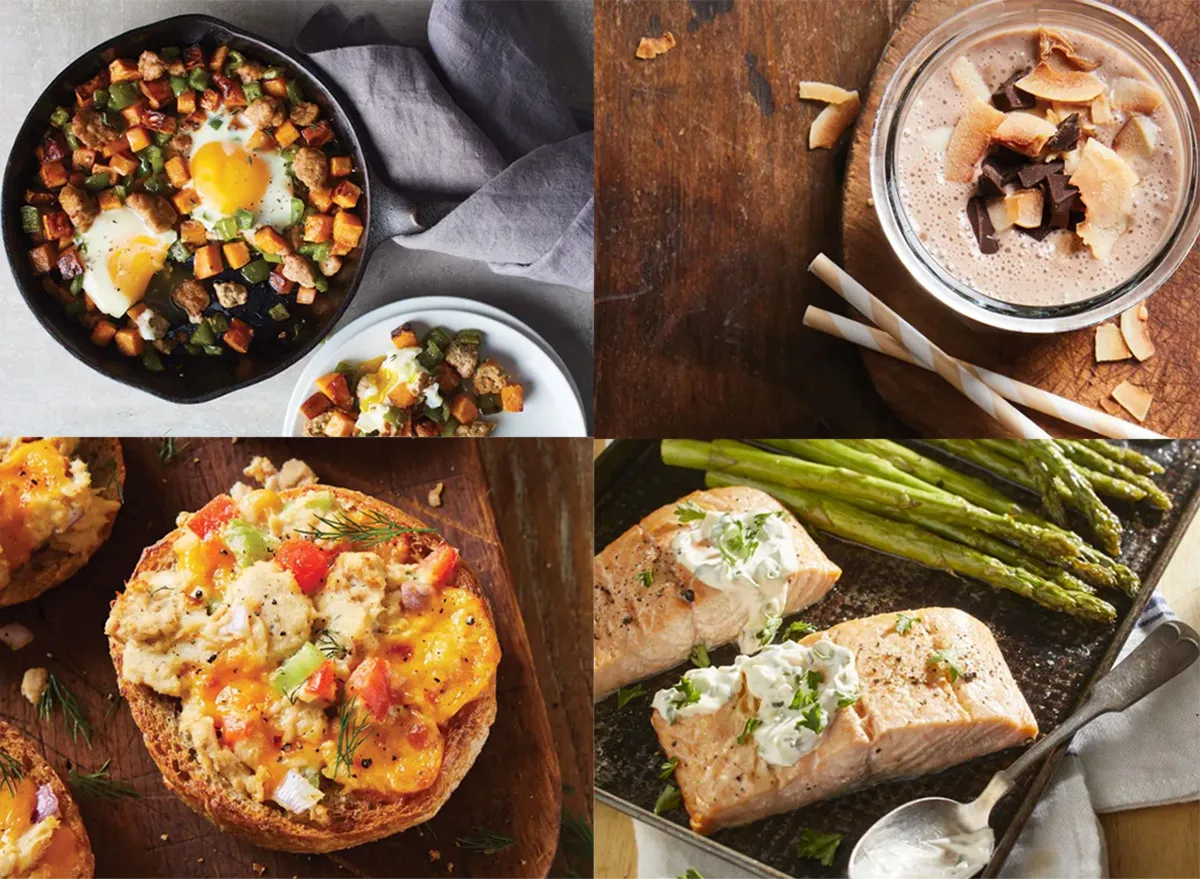
While low-calorie diets might promise quick weight loss, they're bound to leave you hangry, low in energy, and most likely deficient in many essential nutrients. Depending on your unique needs, a 2,000-calorie meal plan can be a more sustainable approach, providing you with all the nutrients you need while you work towards sustainable and safe weight loss goals.
You might notice that nutrition labels on packaged foods base their recommended dietary allowances on a 2,000-calorie diet, but this doesn't mean that everyone needs 2,000 calories every day. That being said, this amount is right in the middle for the majority of adults to maintain a healthy weight.
Read on to find out if a 2,000-calorie meal plan is the right fit for your weight loss goals and get a sample day of meals, complete with recipes, to help you get started.
Who is a 2,000-Calorie Meal Plan Safe For?
While your exact calorie needs depend on a number of factors, including your current weight, gender, activity level, and age, the Dietary Guidelines for Americans have average calorie needs based on gender and age to help you get started.
- Adults aged 31 to 59: Most females need 1,600 to 2,200 calories per day, while males require 2,200 to 3,000 calories.
- Younger adults aged 19 to 30: Calorie needs are higher, with females needing 1,800 to 2,400 calories daily, and males requiring 2,200 to 3,000 calories.
This means that a 2,000-calorie diet may be appropriate for many men and women, although you may need a little more or a little less based on your unique needs and activity level.
How to Determine a Safe Calorie Deficit for Weight Loss
To lose weight, you have to have a calorie deficit, meaning you burn more calories than you eat. This can be accomplished by eating less, increasing physical activity, or a combination of both.
Research suggests that, for most people, reducing calorie intake (or combining reduced intake with increased energy expenditure) by 300 to 600 calories per day can result in a weekly weight loss of about 0.5 to 1 pound.
When determining your own calorie deficit, consider the recommended daily calorie ranges from the Dietary Guidelines for Americans. Consuming too few calories can make it challenging to meet your nutrient needs and is not advised. If you're unsure of the right approach, consult a registered dietitian or physician to come up with a safe and sustainable weight loss plan.
In This 2,000-Calorie Meal Plan
- Breakfast (489 calories): Easy Turkey-Sweet Potato Breakfast Hash (422 calories) and one sliced peach (67 calories)
- Morning Snack (183 calories): Chocolate Coconut Banana Smoothie
- Lunch (517 calories): Veggie Tuna Melt (347 calories), Butternut Squash Soup (150 calories), and baby carrots (20 calories)
- Afternoon Snack (225 calories): Non-fat Greek yogurt (5 oz) with raspberries (½ cup) and chopped walnuts (½ oz)
- Dinner (586 calories): Butter-Baked Salmon and Asparagus
Breakfast
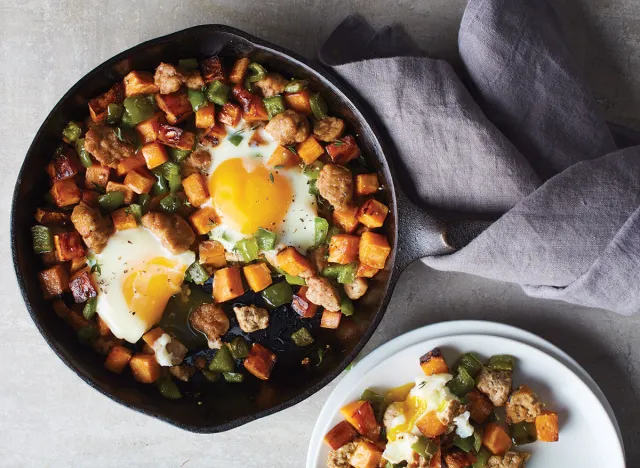
Aim for a breakfast between 400 and 500 calories.
Sample breakfast:
- Easy Turkey-Sweet Potato Breakfast Hash (422 calories)
- One peach, sliced (67 calories)
While this 489-calorie breakfast fits within a 2,000-calorie diet, its combination of protein and fiber helps keep you feeling full and satisfied. The dish features sautéed sweet potatoes and green bell peppers mixed with turkey sausage and eggs, providing 26 grams of protein along with a balance of healthy fats and complex carbohydrates.
Finishing your breakfast with a juicy peach is the perfect sweet treat that adds 2 grams of fiber and 13% of the daily value (DV) of vitamin C.
Other breakfast ideas:
- Healthier Denver Omelet and 1 slice of sourdough toast (468 calories)
- Oatmeal With Peanut Butter and Banana and two chicken sausage links (480 calories)
- Scrambled Eggs With Salmon, Asparagus, and Goat Cheese and a banana (433 calories)
Morning Snack
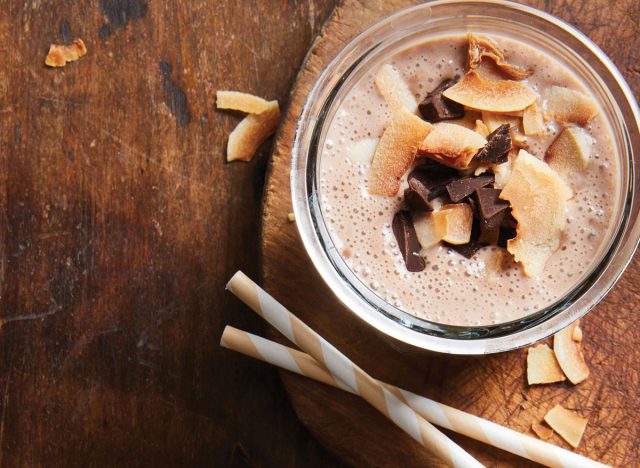
Aim for a snack between 150 and 250 calories.
Sample snack: Chocolate Coconut Banana Smoothie (183 calories)
Smoothies are a convenient mid-morning snack that help curb hunger and boost your daily nutrient intake. This chocolate coconut banana smoothie comes in at under 200 calories and tastes like dessert, while offering the benefits of probiotics and protein from Greek yogurt, as well as fiber and potassium from the banana.
Lunch
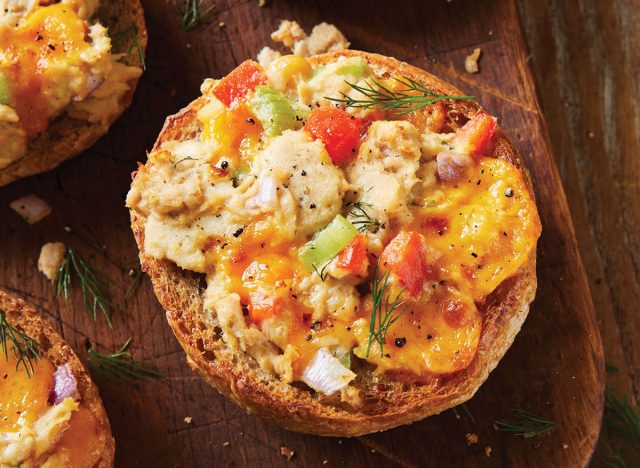
Aim for a lunch between 450 and 550 calories.
Sample lunch:
- Veggie Tuna Melt (347 calories)
- Butternut Squash Soup (150 calories)
- 2 ounces baby carrots (20 calories)
A typical tuna sandwich gets a nutrient upgrade with the addition of chickpeas, peppers, onion, and celery. Plus, we've swapped out the mayonnaise for a combination of Greek yogurt and dijon mustard. Paired with butternut squash soup and a handful of baby carrots, this meal is incredibly filling and nutrient-rich, adding 517 calories to your day. Plus, it's a great source of vitamins A and C, and rich in fiber from the squash and chickpeas.
If you eat lunch away from home or are short on time, you can easily make a big batch of the tuna salad and soup on the weekend to eat for lunch throughout the week.
Other Lunch ideas:
- Veggie and Chicken Loaded Calzone and a glass of 1% milk (501 calories)
- Caprese Sandwich and Baked French Fries (490 calories)
- Grilled Caesar Salad with a cup of grapes (472 calories)
Afternoon Snack
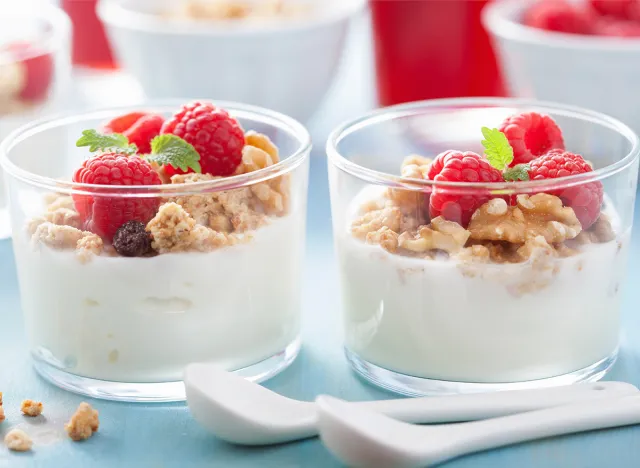
Use this snack to help round out your day. Include anywhere from 150 to 300 calories to help you meet your goal.
Sample snack: A 5 ounce container of non-fat Greek yogurt with ½ cup of raspberries and ½ ounce of chopped walnuts (225 calories)
A yogurt parfait is the perfect afternoon snack to help you power through until dinner time and help meet your calories, protein, and fiber goals for the day. Greek yogurt is rich in protein and probiotics, while raspberries offer a fiber-rich fruit option. Add some chopped walnuts on top for a boost of omega-3 fatty acids and a satisfying crunch!
Dinner
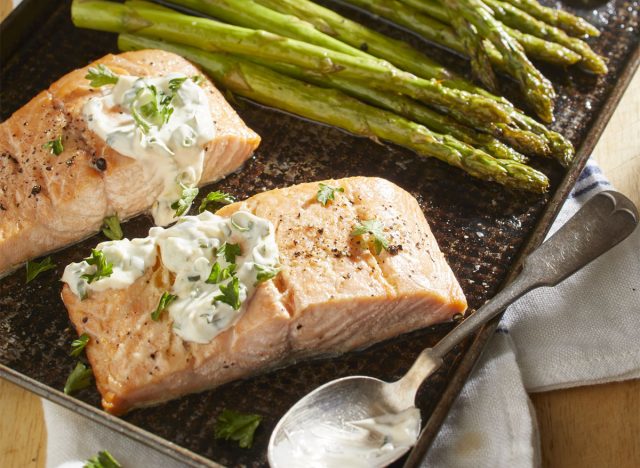
Aim for a dinner between 500 and 600 calories for dinner.
Sample dinner: Butter Baked Salmon and Asparagus (586 calories)
End your 2,000-calorie day with a simple butter-baked salmon and asparagus sheet pan meal. Although this meal is higher in fat, it's rich in omega-3 fatty acids DHA and EPA, which have a positive influence on inflammation, cholesterol, blood pressure, and insulin resistance. Plus, the healthy fats in this meal are incredibly satisfying, helping you stay full throughout the evening instead of reaching for late-night snacks.
Other dinner ideas:
- Honey-Mustard Glazed Salmon With Roasted Asparagus and Crispy Rosemary Potatoes(520 calories)
- Grilled Flank Steak with Chimichurri and a warm corn tortilla (500 calories)
- Herb Roast Chicken with Root Vegetables and Parmesan Roasted Broccoli (520 calories)
Total Calories: 2,000
2,000 (489 breakfast + 183 snack + 517 lunch + 225 snack + 586 dinner)
Final Thoughts
A 2,000-calorie diet can be effective for weight maintenance or weight loss, but it's important to understand your own calorie needs to achieve your goals. This 2,000-calorie meal plan is an example of what a nutrient-dense day could look like, including three meals and two snacks. For personalized guidance, consult a physician or dietitian to develop a healthy and sustainable weight loss plan.









